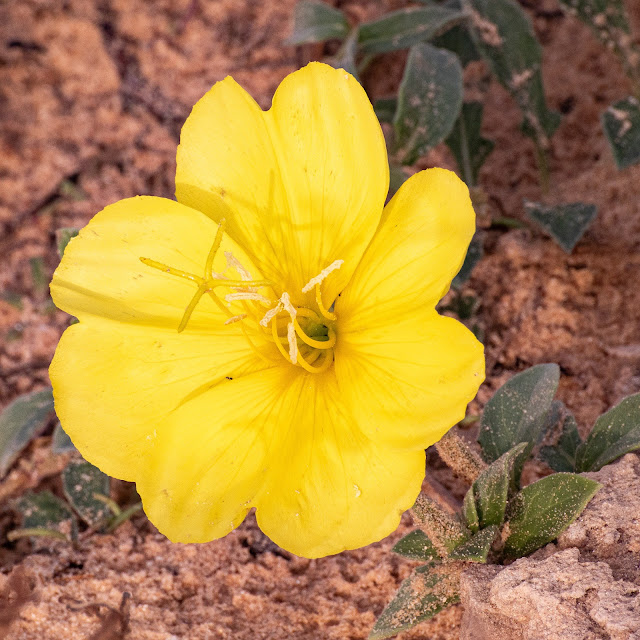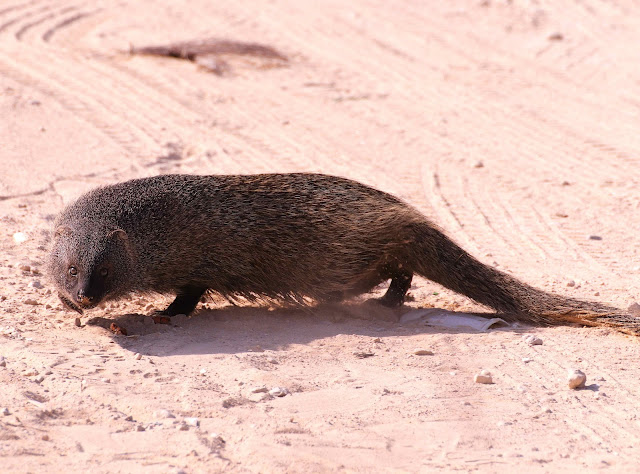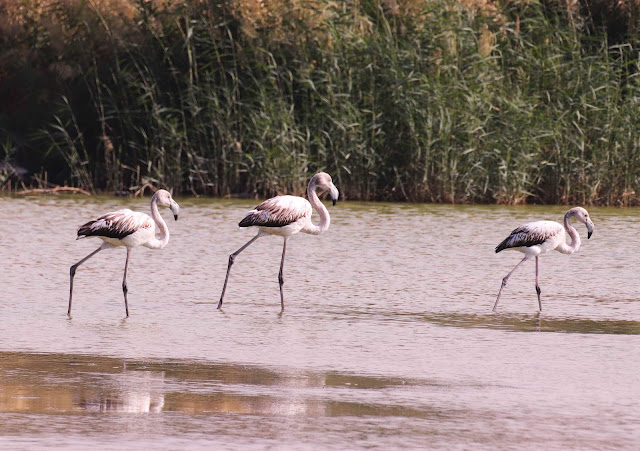26th December 2023
On one of our recent walks along the
coast near Netanya I photographed these plants and flowers. The beautiful
yellow flower, growing on the sand dunes, is the evening primrose. And the bush
with a rosette of large, thick, fleshy leaves is an aloe – American aloe also
known as century plant. It sends up hugely long flower stalks, as you can see
in one of the photos, reaching up to 8m (26ft). It looks similar to a cactus,
but it isn’t a cactus, and despite one of its names it isn’t actually an aloe. It
gets its name century plant, because it is semelparous, that is it only flowers
once, at the end of its life. It doesn’t actually live to be a hundred years,
but still has a good long life of up to thirty years.
I saw on Facebook an amusing post – see
the photo. Two elderly British ladies greet each other – “aloe Vera” says one,
to which the other replies “evening Primrose”. My version seems to be an
American lady and a British lady greeting each other - “aloe American” says the
British lady, to which the American replies “evening Primrose”.
---
21st December 2023
From
time to time when we’re out and about we see (and sometimes we just hear) wild
boar – wild pigs. Not so long ago we were lucky enough to watch a large sounder
of boars cross the road in front of us – there may have been 20 or more adult
females and perhaps 20 or more boarlets. Of course, I stopped the car quickly,
got out my camera and headed towards them. Drivers of other cars passing by
started honking loudly and the sound o’ their horns was enough of a signal to the
boars to run away at quite some speed – leaving me without a single photograph
– but I was alive, thanks to the quick-thinking motorists.
So, just
how dangerous are wild boar? If they feel threatened or if they think their
young are under threat, they will charge and each year a few people lose their
lives as a result. If only they knew that in Israel with a Jewish and Muslim
population there is no chance, they’re going to end up on someone’s dinner
plate, then I would probably be able to photograph them more frequently.
I don’t
want to bore you with tales of my heroics but a few years ago, while out on a
country walk near Rosh Pinna we came face to face with a boar and her young. The
young ran to safety quickly, but the sow stood her ground, snorting and
growling, and I (being a bit pig-headed) stood mine, despite Miriam’s near-hysterics.
If I had been holding a 12-bore shotgun, the pig would perhaps have been under
real danger, but my Canon was considerably less of a threat. After ‘shooting’
the boar, I retreated slowly, and she went off too. Here’s my ‘trophy’.
18th December 2023
Yesterday, on our way to Netanya to do
our grandparenting duty, we stopped for a coffee and a walk in the Nature Park
at Ramat Hanadiv. After just a few minutes a truck stopped next to us on one of
the tracks and there was Dr Tzach Glasser, the Nature Park manager. Tzach had
been kind enough to give Miriam and me a guided tour of the park a few months
ago. As we chatted, I recalled our conversation earlier in the year about
Griffon vultures.
The Eurasian
vulture (Gyps fulvus) known as the Griffon vulture is a large bird of
prey with a wingspan of more than 2½ metres. Not so long ago, there were
numerous Griffon vultures in Israel, but in recent times they have become
scarce. Various programs to help them re-establish themselves in Israel are in
place, including at Gamla in the Golan. At Ramat Hanadiv, a few pairs of these
vultures have been imported from Europe – they’re not able to survive in the
wild, because of injuries they sustained, but they can be used to breed birds
that can be released into the wild. Tzach explained that they only produce one
egg a year, but if they remove that egg (and incubate it artificially), the
vulture will lay another to substitute for the lost egg. In that way they can
double the number of chicks born in a year.
We didn’t see vultures at Ramat Hanadiv,
though, we did see them on a recent trip to Hai Bar on Mount Carmel, near
Haifa.
Yesterday we saw a butterfly that is not
nearly as common, as some that we see. It was the Archon apollinus, the
false Apollo, with a conservation status of ‘near threatened’. I’m not sure why
it deserves the acclaim false Apollo, but I guess it’s because
although it is fast, it isn’t really a rocket.
We also saw a beautiful jay and some
wild crocuses.
---
14th December 2023
We had a
very pleasant afternoon in Zichron Yaakov one day last week. We had lunch in
the café at Ramat Hanadiv and then a walk in the park/gardens. I found a
friendly frog to chat to – it was sitting on a lily pad (not on a toadstool). I
also photographed various flowers and at about 15:20 an old and tired lady
gazing into space.
Over the last few years Ramat Hanadiv has become one of our favourite places in Israel. Miriam has written a piece of music to accompany some of my photos. If you have 3 minutes 40 seconds you can watch/listen here:
---
11th December 2023
Yesterday, Miriam
and I spent the day looking after our little grandson (18-months-old) who had
the day off kindergarten. We thought he might like to go to a ‘gymboree’ but
decided he’d probably prefer a visit to the Viker Lookout (near Netanya) to see
the pelicans that flock to the lake there.
Anyway, our
grandson enjoyed very much, riding his bimba up and down the ramps at
the Viker Lookout. Incidentally bimba is a Hebrew word (I think from
Arabic) for a trike without pedals, propelled by a child’s feet. And his Saba
(Hebrew for grandfather) enjoyed very much, observing pelicans flying in by the
score and landing on the lake.
It was
interesting to watch the pelicans glide across the lake, near the surface of
the water, benefitting from the ground effect. As any pilot or aeronautical
engineer will tell you, when flying near the ground or water surface there is
reduced drag and more uplift, so the flyer, be it a bird or a plane (or even Superman)
expends less energy.
These two
photos are from this week.
---
A week or
two ago I wrote about geckos, including the house gecko. When we returned from
Netanya late yesterday evening, and walked into our apartment, I saw what I
thought was a cockroach scurry under the sideboard. I shone my phone torch
under the sideboard and a little 3-inch (7.5 cm) pink Mediterranean gecko (also
known as the house gecko) ran quickly to a safer place. So, there are now three
of us living in the apartment, Miriam and me and Gary Gecko. I hope it’s as
good at catching mosquitos as it’s meant to be.
---
7th December 2023
The Turtles and the Mallard
We had a short walk last week at the River
Alexander near Netanya. This is one of the best places in Israel to see African
softshell turtles. Sometimes they keep a low profile and are hard to spot, but
we were lucky on this visit to see a group basking in the warm November sun. We
spent quite some time watching one particular turtle which seemed to enjoy
retracting its head into its soft shell, to the point that it was barely
visible. Turtles and tortoises, (as well as turtoises and tortles as Nash would
have it) retract their heads and withdraw into their shells to keep safe from
predators. But these softshell turtles are so huge (about a meter long and
weighing 40kg) that they’re rarely troubled by anything aside from perhaps crocodiles,
which are not found in Israel other than in zoos. It’s thought that some
turtles hide their heads, so they’re not noticed by the fish and crustaceans on
which they feed, then they surprise them by popping out of their shell rather
quickly. And be careful! Although they don’t have teeth they could take your
finger off with their powerful jaws – so don’t get too close. The biggest
danger to the softshell turtles is actually children on school trips who love
to throw them bits of their sandwiches, which the turtles eat but can’t digest.
Alongside the turtles was a sitting duck, a
rather lovely male mallard. They seemed to ignore each other. The duck was a
bit big for the turtles to make a meal of, and in any event, it’s an expert at
ducking and diving.
---
5th December 2023
Almost directly across the Kinneret (Sea of
Galilee) from Tiberias is a small fishing port-cum-kibbutz called Ein Gev,
which we visited yesterday. We opted for the scenic route, that is the 25km
drive round the South side of the lake rather than the most direct route, a 5km
swim, straight across. En-route Miriam asked me what I hoped to see –
paraphrasing Basil Fawlty, I said I would like to see the Sydney Opera House and
the Hanging Gardens of Babylon, and particularly herds of wildebeest sweeping
majestically across the plain. I wasn’t disappointed – the houses are nice; the
gardens are beautiful; and the egrets flying across the harbour were certainly
majestic.
The egrets took a keen interest in the
fishing boats hoping to be thrown unwanted fish rather than have to work hard
for their catch. I spent quite some time observing one bird that stood
patiently at the edge of harbour, for much of the time on one leg.
While I was watching I did a quick bit of
research:
- The world record for a man to stand on one
leg is a staggering 76 hours and 40 minutes
- Standing on one leg improves posture,
reduces back pain, keeps your circulation going and burns calories.
- A person in their 50s should be able to
stand on one leg for 40 seconds, someone in their 60s for about 20 seconds and
someone in their 70s for around 10 seconds – I think I might be younger than my
birth certificate indicates.
But more importantly, I discovered that there
are two main reasons why birds stand on one leg. Primarily, tucking one of its
unfeathered legs into its feathered regions reduces heat loss. Tucking up both
legs would further reduce heat loss but any bird doing this would probably become
a sitting duck. This week the temperature was about 28 Centigrade, and even
though that’s on the cool side for our region (though not at this time of year),
the egret shouldn’t have felt the need to conserve heat. The other reason that
birds opt for a single-legged position is to rest the other leg. Personally, I
find it better to sit in an armchair with both feet raised.
The three photos show the bird on both
legs, on its right leg and on its left leg.
If you have four minutes, you might like to
listen to some of Miriam’s music accompanying a slide show of my photos of
egrets – it’s here:
---
In
yesterday’s post, I included a picture of an olive tree that is more than 500
years old. My daughter, Naomi, asked how we can tell that it is 500 years old. There’s
actually a little sign on it that reveals its age, but generally speaking how
can you tell how old a tree is, if there isn’t a sign on it? It’s well known
that you can count rings in the tree trunk to determine the age – but in a tree
that’s still standing that presents a challenge. Dendrochronologists (that’s
the posh word for those who count tree rings) use increment borers to age trees
harmlessly by taking an extract from the tree (sounds a bit like a biopsy).
But
there is an altogether simpler method that requires just very basic maths. The
thickness of the trunk gives a very good indication to the trees age. The
diameter of a cross section of the trunk increases each year by approximately
2mm – therefore its radius increases by 1mm each year. So, if you measure the
girth of the trunk (that is the circumference) you can calculate the radius.
For a
circle, Radius = (½ X Circumference) / π (Pi)
If the circumference
of a tree is 3.14 metres the radius will be ½ metre = 500 mm
So, a
tree with a girth of 3.14 metres will be approximately 500 years old.
Next
time you’re hugging a tree, if you can’t get your arms all the way round, you
can be sure it’s quite an old tree.
It
occurs to me that given my waist girth (32 inches), if I were a tree, I’d be
about 129 years old (twice as old as I am). Perhaps it’s time to branch out.
---
Naomi
also told me that they get geckos (which I wrote about last week) in their
house from time to time. I think they’re probably Mediterranean house geckos.
Can’t say I’d fancy one walking across my bedroom ceiling – but on the other
hand they’re mosquito eaters, and mosquitos eat me, so maybe I should get a pet
gecko.
---
If
elephants could fly …
While
in Netanya earlier this week, a cattle egret flew over me – here it is. The
cattle egret is also known as the ‘elephant bird’, though in my opinion it
doesn’t look any more elephantine than the elephant’s ‘cousin’, the Syrian rock
hyrax (that I photographed last week at Mount Arbel).

-2.jpg)
-2.jpg)


.JPG)
.JPG)
.jpg)
.jpg)
.jpg)
.jpg)
.jpg)
.jpg)
.jpg)
.jpg)
.jpg)
.jpg)










.JPG)
.JPG)
.JPG)
.JPG)



.jpg)
.jpg)
.jpg)
.jpg)
.jpg)
.jpg)



.JPG)
.JPG)
.JPG)
.JPG)
.JPG)
.JPG)
.JPG)




.JPG)
.JPG)
.JPG)
.JPG)
.JPG)
.JPG)






-2.jpg)

